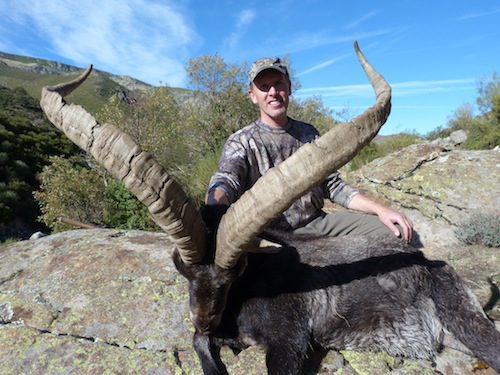Gredos Ibex
Undoubtedly, the Gredos Ibex reigns supreme among the Spanish subspecies of ibex. The Gredos Ibex, renowned and widely recognized among the various species of Spanish Ibex, finds its habitat in the majestic Gredos Mountains, nestled in the western region of the country. Throughout the ages, this noble creature has persevered as a regal species, safeguarded by the ancient monarchs of Spain.
They boast an impressively large bodies, and are distinguished for their remarkable horns, which gracefully curve akin to the delicate strings of a lyre.
Ask About an Ibex Hunt
Upload Image...
Himalayan Ibex
The enigmatic Himalayan Ibex, true to its name, finds its dwelling amidst the majestic Himalayan peaks, which stand as the loftiest mountain range known to mankind. Within the depths of Pakistan, nestled in the far-flung and untamed recesses of the land, lies an opportune hunting ground where time seems to have left the local communities untouched for millennia. Remarkably, those who have ventured into this realm attest that the region’s fearsome reputation is significantly embellished.
Envisioned as awe-inspiring trophies, the Himalayan subspecies of ibex possess elongated horns, reminiscent of scimitars, adorned with knobby protuberances that may extend well beyond the remarkable span of four feet. These majestic antlers embody the quintessential emblem of an unparalleled escapade into the realm of mountain hunting, set against the backdrop of a rugged and primordial terrain.
Ask About an Ibex Hunt
Upload Image...
Kri-Kri Ibex
The kri-kri ibex, also known as the Cretan goat, Agrimi, or Cretan Ibex, is a feral goat species that can be found in the Eastern Mediterranean. It was previously considered a subspecies of the wild goat. The kri-kri has a light brownish coat with a darker band around its neck and two horns that sweep back from its head. It is known for its agility, being able to leap long distances and climb seemingly sheer cliffs.
While the kri-kri is not native to Crete, it is believed to have been introduced to the island during the time of the Minoan civilization. However, it is now endemic to Crete and can be found nowhere else. The kri-kri used to be widespread throughout the Aegean region, but its population has dwindled, and its last strongholds are in the White Mountains of Western Crete. These mountains, reaching heights of 8,000 ft (2,400 m), are home to various endemic species, including the kri-kri. One notable location within the White Mountains is a series of almost vertical 3,000 ft (900 m) cliffs known as “the Untrodden,” located at the head of the Samaria Gorge.
The kri-kri’s habitat also extends to the Samaria National Forest and the islets of Dia, Thodorou, and Agii Pantes. The entire region, including the White Mountains, is recognized as a UNESCO Biosphere Reserve, offering protection to the kri-kri and other endemic animal species found there.
Despite its previous presence in the Aegean, the kri-kri’s survival now heavily relies on the conservation efforts in the protected areas of Crete. The species tends to be shy and avoids human interaction, often resting during the day and displaying their impressive climbing and leaping abilities when needed.
Overall, the kri-kri holds ecological significance as an endemic species of Crete and serves as a symbol of the unique biodiversity found in the region’s mountainous landscapes.
Ask About an Ibex Hunt
Mid-Asian Ibex
The most common subspecies of ibex, therefore the least expensive to hunt. Although they’re common, they are also the most difficult to hunt, as they live in extremely high altitudes. This subspecies of the Siberian Ibex (Capra siberica), can be found in the mountain ranges north of the Himalayas and south of Siberia. This includes regions such as the Tian Shan and the Pamir, also known as the “Roof of the World.” These ibex are primarily located in the territories of former Soviet republics, Found in Kyrgyzstan, Tajikistan, Kazakhstan, it’s common to combo these a Mid-Asian ibex hunting trips with a Marco Polo sheep or a Tian Shan Wapiti.
Kyrgyzstan has been among the most popular destinations for international mountain hunters. On the other hand, Tajikistan has gained recognition among mountain hunters due to its award-winning community-based conservation program.
A Mid-Asian Ibex hunt is often regarded as one of the best bargains in the category of adventure mountain hunting trips to true wilderness areas. It is a classic mountain hunt where the spot-and-stalk method is employed. The hunter and the guide will typically start early to reach higher elevations since ibex do not anticipate danger from above, making it advantageous to position oneself higher than them.
Overall, a Mid-Asian Ibex hunt offers hunters the opportunity to engage in a challenging and exciting adventure amidst stunning mountain landscapes, and it is considered a classic pursuit for those seeking a memorable hunting experience.
Ask About an Ibex Hunt
Upload Image...
Nubian Ibex
The magnificent Nubian ibex roams the enchanting Red Sea Hills of Egypt and Sudan, as well as the majestic mountains of Eritrea. This captivating creature also graces the Sinai Peninsula in Egypt, and can be observed in Israel, the southwestern region of Jordan, and even the wondrous Arabian Peninsula. It possesses a more delicate and nimble frame compared to other subspecies of ibex, and its elegant horns boast a slender allure. Its coat showcases a gentle hue of light brown, adorned with a striking dark dorsal stripe, while its legs proudly display distinctive black-and-white markings. Furthermore, its beard, long and velvety, emanates a deep darkness.
Notably, the Nubian ibex distinguishes itself from the Asian and Alpine ibex through its horns, which possess a graceful narrowing and rounded outer edges. In the realm of Asian Nubian ibex specimens, they tend to be marginally smaller than their African counterparts, with horns that are shorter and more slender.
Ask About an Ibex Hunt































